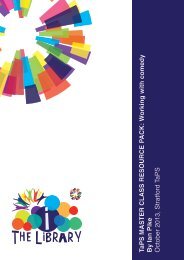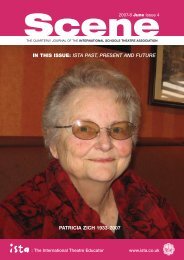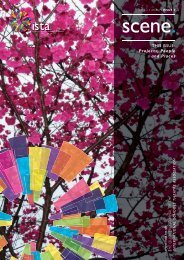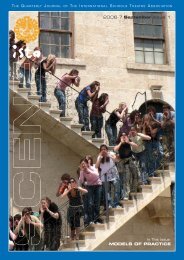SILENT MOVIES by Georgina Christou Extracted from Scene ... - Ista
SILENT MOVIES by Georgina Christou Extracted from Scene ... - Ista
SILENT MOVIES by Georgina Christou Extracted from Scene ... - Ista
Create successful ePaper yourself
Turn your PDF publications into a flip-book with our unique Google optimized e-Paper software.
<strong>SILENT</strong> <strong>MOVIES</strong> <strong>by</strong> <strong>Georgina</strong> <strong>Christou</strong><br />
<strong>Extracted</strong> <strong>from</strong> <strong>Scene</strong> 2011-12 March Issue 3
and funding for butoh in New York, partnering with Japan<br />
Society and receiving support <strong>from</strong> the Rockefeller Multi-Arts<br />
Production Fund, among other institutions. The fi rst festival<br />
featured Waguri Yukio (Tokyo), SU-EN (Sweden – former<br />
student of Ashikawa Yoko and member of Gnome), Shinonome<br />
(Tokyo), Joan Laage (Seattle), Shinichi Koga (San Francisco),<br />
and Zack Fuller (New York). After three biennial festivals with<br />
extensive performance, lecture, fi lm screenings, and workshops<br />
in 2003, 2005, and 2007, the organizers transitioned the format<br />
into its current NY Butoh-kan model, focusing on ongoing<br />
workshops with more than 18 different teachers, and training<br />
the next generation of dancers (340 unique students to date).<br />
They continue to co-produce performances for visiting masters<br />
with partner organizations such as Dance New Amsterdam,<br />
though not on the scale of the earlier festivals. They have<br />
facilitated opportunities for local dancers to perform in the<br />
works of visiting butoh masters, including Kasai Akira (Butoh<br />
America presented <strong>by</strong> Japan Society), Murobushi Ko (Furnace<br />
presented at Dixon Place), and Waguri Yukio (La<strong>by</strong>rinth of Body<br />
presented at CAVE).<br />
New York being the large arts community that it is, there<br />
are other artists and producers that present various workshops<br />
and performances with butoh masters. These include Frenchborn<br />
butoh dancer Vangeline, who founded Vangeline Theater<br />
in 2002 and frequently presents Diego Piñon and Katsura Kan,<br />
as well as coordinates a project for incarcerated women to<br />
study butoh. Vangeline’s work focuses on ritual and healing,<br />
infl uenced <strong>by</strong> Piñon’s Butoh Ritual Mexicano.<br />
New York is a transient and disparate artistic community,<br />
though, and without the continuous presence of a butoh<br />
master like the Tamanos, who founded the fi rst American butoh<br />
community in San Francisco, where they taught and created<br />
work for more than 40 years, there is no consistent style or<br />
lineage visible among the many artistic groups here that claim<br />
butoh as a guiding infl uence in their work. At the same time,<br />
there is also a great deal of experimentation – artists exploring<br />
intersections of butoh with theater, digital and visual arts, music<br />
and vocal improvisation, and burlesque. Perhaps this irreverent<br />
mixing is necessary to bring butoh into its future potential (which<br />
is also ironically returning it to its roots as an experimental art<br />
form). Still, one needs a solid foundation and deep engagement<br />
with any language if one is to learn how to use it properly.<br />
Yoshito commented that Hijikata fi rst built something that he<br />
could then break. Many students came to Hijikata with no prior<br />
dance or movement training, and so he taught them ballet as<br />
a foundation. In his own movement vocabulary, Hijikata mixed<br />
ballet, German Neu Tanz, and pantomime. Yoshito is critical<br />
of the younger generation of dancers who “just jump into the<br />
butoh world with no practice.” He says, “People cannot make<br />
a revolution if they don’t have a foundation,” so they should<br />
“make fi rst, then break.”<br />
Sources:<br />
Anderson, Jack. “Dance in Review: Poppo and the Go-Go Boys<br />
La Mama.” New York Times. October 25, 1993<br />
Garnica, Ximena. Personal email to author, November 26, 2011.<br />
Kuniyoshi, Kazuko. “Butoh Chronology: 1959-1984.” The<br />
Drama Review: TDR , Vol. 30, No. 2 (Summer, 1986), pp.<br />
127-141<br />
Ono, Yoshito. Personal interview with the author, November<br />
8, 2010.<br />
Schechner, Richard, “Kazuo Ohno Doesn’t Commute,” The<br />
Drama Review: TDR, Vol. 30, No. 2 (Summer, 1986), pp. 163-<br />
169.<br />
Stein, Bonnie Sue. “Butoh: Twenty Years Ago We Were Crazy,<br />
Dirty, and Mad.” The Drama Review: TDR , Vol. 30, No. 2<br />
(Summer, 1986), pp. 107-126<br />
www.cavearts.org<br />
www.eikoandkoma.org<br />
www.jinen-butoh.com<br />
www.kazuoohnodancestudio.com<br />
<strong>SILENT</strong><br />
<strong>MOVIES</strong><br />
By georgina <strong>Christou</strong><br />
The need to fi ll a silence during performance is one of the main<br />
misconceptions for drama students. But acting without words is what truly<br />
turns a student into an actor. Silent Movies is the fi rst unit I look at when the<br />
students enter the drama program in Year 7. Making them aware that they<br />
are always acting because in reality over 70% of how we communicate is<br />
through non-verbal communications and let’s face it, actions speak louder<br />
than words.<br />
Year 7 Silent Movies<br />
About the unit<br />
This unit looks at how silent movies are created. It focuses<br />
specifi cally on the use of non-verbal communications such as facial<br />
expressions, body language and exaggeration. Students work<br />
towards creating their own silent movie for assessment.<br />
Aims<br />
• To explore through drama skills and conventions the genre of<br />
‘silent movies’.<br />
• To become familiar with working with a variety of students in a<br />
productive way to create creative performances.<br />
• To develop skills needed to create an original silent movie.<br />
Essential Questions<br />
Do we really need to speak to communicate<br />
Objectives<br />
• To be able to improve physical control<br />
• To exaggerate movements and facial expressions<br />
• To respond to different pieces of music<br />
• To work with others to create a performance<br />
• To respond through mime to a story<br />
• To create an ending, with the help of others<br />
• To be able to create an original silent movie<br />
Lesson Mapping<br />
Lesson 1 – Introduction to Mime<br />
Lesson 2 – The fi ght/chase<br />
Lesson 3 – Mood Music<br />
Lesson 4 – The Poor Wretch<br />
Lesson 5&6 – An original Silent Movie (Assessment)<br />
Resources<br />
Instrumental music<br />
The Pink Panther theme tune<br />
Charlie Chaplin Clip – YouTube<br />
Placard – Example attached to unit<br />
Blank Paper<br />
Felt Pens / Pencils<br />
The Poor Wretch – Story attached to unit<br />
54 Issue 3 | 2011-12 March | <strong>Scene</strong>
Lesson 1 – Focus: Exaggeration<br />
Resources<br />
1) Music<br />
2) YouTube clips – Charlie Chaplin and mime<br />
Objective:<br />
• To improve physical control<br />
• To exaggerate movements and facial expressions<br />
Starter / Introduction:<br />
Introduce Mime.<br />
Show a picture of Charlie Chaplin and ask members of the class if they know who<br />
he is.<br />
Show a short clip <strong>from</strong> ‘City Lights’<br />
• Discussion on silent movies – can you understand what is going on even though<br />
there is no dialogue<br />
• What else do they use to aid the storyline (music, placards)<br />
Inform the class that in 5 weeks they will create their own Silent Movie.<br />
Development:<br />
Starter – whole class<br />
Going round the circle each student must mime receiving a gift box and opening<br />
it to reveal what is inside. (teacher to model first) Students can decide the size of<br />
their box.<br />
Pairs<br />
Ask the students to imagine that they are throwing a tennis ball to one another.<br />
• stop them and model some good examples<br />
• ask them to re-do the exercise particularly focusing on their eye line and<br />
‘seeing’ the ball<br />
*Please note: you may also play around with the size and weight of the ball to<br />
make the exercise fun!<br />
Task – individually<br />
Each student must create an exaggerated mime of trying to frantically tear up a<br />
piece of paper BUT no matter how hard they try It will not tear!!<br />
Now ask the students to try and pick up a coin that is stuck to the floor – again no<br />
matter how hard they try it will not budge!<br />
*Add music to the previous task. (slow, depressing track followed <strong>by</strong> an upbeat<br />
track)<br />
Q. How does music change the scene<br />
Q. Does it help to inform us about character<br />
Task – Groups of 4<br />
Working as a team try and dislodge a chair stuck to the ground. Remember to<br />
exaggerate!<br />
Task – Groups of 4 / 5<br />
Create a routine that has a clear beginning, middle and an end that involves sticky<br />
glue.<br />
Q. How can we make this funny<br />
Q. How can exaggeration be used<br />
Watch and evaluate<br />
Q. Identify a specific moment when the group used clear exaggeration.<br />
Key Words:<br />
• Exaggeration<br />
• Music<br />
Lesson 2 – Focus: Placards<br />
Resources<br />
1) Paper<br />
2) Felt tips / colored pencils<br />
3) Example of a placard<br />
Objective:<br />
• To improve physical control<br />
• To exaggerate movements and facial expressions<br />
Introduction (Or Starter):<br />
Starter: going around the circle students must mime an everyday activity – others to guess. Teacher to model first.<br />
If necessary show another silent movie clip (recommended – The General <strong>from</strong> YouTube)<br />
Recap learning so far.<br />
Development:<br />
Task – individual<br />
Ask students to mime the following actions on the spot;<br />
• Running,<br />
• Throwing a punch<br />
• Performing a kick<br />
• Pointing a finger<br />
Experiment with music and how this can change the actions.<br />
Task – Individual<br />
Using still poses ask the students to show these different stock characters;<br />
• A teacher<br />
• A homeless person<br />
• A police officer<br />
• A bully<br />
• A hero<br />
Model good examples as you go along and encourage students to use as much<br />
exaggeration as possible in their facial expressions and body language.<br />
Q. why is (name of student) so successful in their portrayal of (stock character).<br />
Q. what are they doing to make it super clear<br />
Task – Pairs<br />
Use 3 still images to create a non-contact fight scene.<br />
(Make it clear that this work takes the form of still images and it is not an<br />
opportunity to play fight!) Remind students of lesson objectives.<br />
*introduce placards (example words: Pow! Crash! Bang!)<br />
Q. where are these commonly seen (comics)<br />
Ask the students to create one placard per pair to include in their scene.<br />
Task – Pairs<br />
Show a chase scene through 3 still images. Move between each image in slow<br />
motion.<br />
*Ask the class to perform either the fight scene or chase scene.<br />
Class to evaluate in relation to Learning Objectives.<br />
Key Words:<br />
• Exaggeration<br />
• Music<br />
www.ista.co.uk <strong>Scene</strong> | Issue 3 | 2011-12 March 55
Lesson 3 – Focus: Food / Music<br />
Resources<br />
1) CD<br />
2) Paper<br />
3) Felt Tips / Colored Pencils<br />
Objective:<br />
• To respond to different pieces of music<br />
• To work with others to create a performance.<br />
Starter / Introduction:<br />
Recap learning<br />
What does the key word: plot mean<br />
Development:<br />
Task – small groups<br />
Ask the students to listen to four pieces of music <strong>from</strong> the classical CD.<br />
On paper each group must mind map any words that come to mind as they<br />
listen to the tracks. (This could include; thoughts, feelings, emotions, pace etc)<br />
Encourage each group to consider possible plots.<br />
Continue with the task until all four tracks have been played. You may want to stop<br />
after each one and ask for feedback <strong>from</strong> the groups.<br />
Task continues<br />
Ask the students to select one piece of music and create a scene to perform<br />
alongside it.<br />
Encourage them to use the learning <strong>from</strong> previous lessons.<br />
Task continued<br />
Ask the groups to show their piece to another group before they perform to the<br />
whole class and the teacher. This is an opportunity for students to peer assess and<br />
offer constructive criticism.<br />
Performance and Evaluation<br />
Q. What was successful about your piece<br />
Q. What could you work on for next time<br />
Q. How did the music help to shape your performance<br />
Q. Why is useful to gain advice <strong>from</strong> other groups before you perform to the<br />
entire class<br />
Q. What does ‘plot’ mean<br />
Key Words:<br />
• Plot<br />
• Mind Map<br />
• Peer Assessment<br />
Lesson 4 – Focus: The Poor Wretch<br />
Resources<br />
1) Poor Wretch Story<br />
2) The Pink Panther theme tune<br />
Objective:<br />
• To respond through mime to a story<br />
• To create an ending to a plot, with the help of others.<br />
Introduction (Or Starter):<br />
Practical warm-up of your choice.<br />
Development:<br />
Task – individual<br />
Teacher narrates the poor wretch story to the class, whilst the class acts out the<br />
movements. Encourage the students to do this alone without interaction with<br />
one another. *Dimming the lights in the room often helps for those more self<br />
conscious.<br />
All students should end up lying on the floor ‘chained to the train tracks’!!<br />
Ask the class to recap what has happened.<br />
Task – Groups 4 / 5<br />
Students must devise the ending to this story. They will all begin at the train tracks.<br />
It can end with a hero/heroine coming to the rescue. It must finish with a still image.<br />
Characters to include (group size permitting)<br />
• poor person<br />
• evil landlord<br />
• evil sidekick<br />
• hero / heroine<br />
• police<br />
*after a few minutes rehearsal stop the class and play the Pink Panther theme tune.<br />
Ask them to perform their ending to this track.<br />
Perform and evaluate<br />
Q. How did they clearly show character<br />
Q. How did music help<br />
Key Words:<br />
• Music<br />
• Character<br />
56 Issue 3 | 2011-12 March | <strong>Scene</strong>
Lesson 5/6 – Focus: Performance<br />
Resources<br />
1) Video Camera<br />
2) Paper<br />
3) Music<br />
Objective:<br />
• To be able to create an original silent movie<br />
Introduction (Or Starter):<br />
Recap all previous lessons and learning. (Slow motion, placards, use of music, stock characters, exaggeration)<br />
Development:<br />
Assessment Task – groups decided <strong>by</strong> teacher<br />
Information for the students:<br />
‘In groups you must create a silent movie that has a clear start, middle and an end.<br />
It must last no longer than 3 minutes and incorporates your learning in this topic’.<br />
You will be assessed individually on character and on movement’<br />
Get the students to decide on a plot, structure and characters.<br />
Decide what information can be given to the audience on a placard. Students may<br />
use music.<br />
This assessment can be given in lesson 5 and performed in lesson 6 if preferred.<br />
Perform and teacher to grade (summative assessment)<br />
*silent movies can be video recorded and can form the basis of a self assessment in<br />
addition to the teacher assessment.<br />
Additional information:<br />
Depending on your group you might want to suggest titles as a starting point – for<br />
instance:<br />
• The haunted house<br />
• Surprise!<br />
• The birthday party<br />
• The search<br />
*Students are being assessed on their performance skills.<br />
* Stop the students at a convenient point and go through the assessment criteria.<br />
Key Words:<br />
• Assessment<br />
The Poor Wretch<br />
It’s snowing, it’s very cold – you are shivering.<br />
The house you live in is letting in the wind.<br />
You are starving, you haven’t eaten for days.<br />
You decide to check the cupboards one last time<br />
for something to eat, but they are all empty.<br />
You have an idea! Looking down at your feet<br />
you remove your old boot. Smell the leather –<br />
aaaahhhhh!! Take out the old lace that will do for<br />
dessert. You find an old pan and you take it to<br />
the sink to fill it with water. But alas, the taps are<br />
frozen.<br />
You hobble outside into the snow and collect<br />
some in your pan. You come back inside, shivering<br />
all the time. You find your last match – light it<br />
carefully, light your candle and then hold your pan<br />
over the candle. Slowly the snow begins to melt<br />
and steam rises. You feel better already. Take your<br />
old boot and put it in the pan. Stir it around. Smell<br />
the aroma.<br />
Suddenly you hear a knick at the door. You<br />
ignore it, but it comes again. You go to the door<br />
and open it. There stands the evil landlord and his<br />
more than evil sidekick.<br />
They burst into the room, searching for the<br />
rent, but they find nothing. They march you out of<br />
the house. You plead for mercy, but they force you<br />
to march down the hill. At the bottom of the hill<br />
they tie you to the train track, waiting for the arrival<br />
of the next train!!<br />
OUCH!<br />
The street where I live…<br />
Since moving to Taiwan in 2009 I have<br />
continued to enjoy the extremely safe and<br />
efficient city of Taipei. The local Taiwanese are<br />
kind and welcoming individuals who make you<br />
feel at home even if the vast majority of our<br />
spoken communication is through smiles and<br />
hand gestures (nice ones of course!). Taipei<br />
American School is situated in the heart of the<br />
expat community, Tienmu. We are spoilt for<br />
choice when it comes to eating with a wide<br />
range of western and local restaurants as well<br />
as the popular night markets that specialize in<br />
weird and wonderful foods.<br />
From 2004 – 2010 Taipei’s 101 building held the title as the ‘world’s tallest<br />
building’, it is truly a worthwhile attraction. There are also over 5000 temples<br />
that encourage everyone to join in with their festivals and celebrations.<br />
Although we have our fair share of rain the weather is generally beautifully<br />
warm with clean air and blue skies. During spring, tourists and locals look<br />
forward to the various cherry trees that bloom along the mountains, rivers<br />
and valleys in Taiwan.<br />
www.ista.co.uk <strong>Scene</strong> | Issue 3 | 2011-12 March 57

















